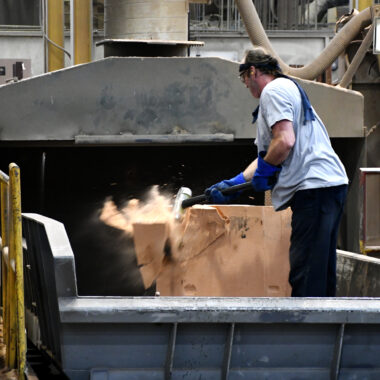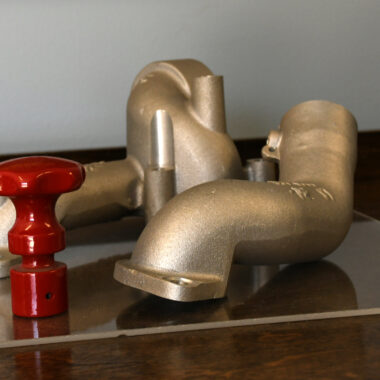Grasping Aluminum Casting: Proven Approaches to Boost Manufacturing Effectiveness
Grasping Aluminum Casting: Proven Approaches to Boost Manufacturing Effectiveness
Blog Article
Unveiling the Different Kinds Of Light Weight Aluminum Casting Processes for Precision Results
Light weight aluminum casting processes play an essential duty in the manufacturing market, supplying a vast array of techniques to attain accuracy results in the manufacturing of intricate components and elements. From die casting to sand spreading, financial investment spreading, permanent mold casting, and centrifugal casting, each technique brings its own collection of ins and outs and advantages to the table. Comprehending the nuances of these processes is important for manufacturers seeking to optimize their production procedures and make certain the finest results. By checking out the distinctive attributes of each spreading approach, a much deeper understanding into the world of aluminum casting can be obtained, clarifying the ideal strategy for attaining precision outcomes in various applications.
Die Casting Process
The Die Casting Refine is a highly effective production method for generating geometrically complicated metal get rid of high precision and repeatability. This procedure involves compeling molten metal into a steel mold dental caries under high pressure. The mold, likewise referred to as a die, is normally made in two components: the cover die half and the ejector die fifty percent. These dies are created to create the wanted shape of the end product.
One of the vital advantages of die casting is its capability to produce components with slim wall surfaces, intricate details, and smooth surfaces. This makes it a favored selection for sectors such as vehicle, aerospace, and electronic devices where intricate steel parts are needed. Additionally, die casting offers outstanding dimensional accuracy, allowing for minimal post-processing needs.
In addition, die spreading can be categorized right into hot chamber and cool chamber die casting procedures. In warm chamber pass away casting, the molten metal is contained in a heating system while in cold chamber die spreading, the molten metal is ladled right into the chilly chamber for each shot. aluminum casting. Each technique has its very own collection of benefits and is chosen based upon the specific needs of the job
Sand Casting Method
Utilizing a centuries-old method, the sand casting method is a widely utilized process in the production market for producing steel elements. This technique includes creating a mold made of compressed sand right into which molten steel is put, permitting it to solidify and take the form of the mold and mildew tooth cavity. Sand spreading is valued for its flexibility, as it can generate a wide variety of complex sizes and shapes, making it ideal for different sectors such as auto, aerospace, and art foundries.
Among the essential benefits of sand casting is its cost-effectiveness, particularly for reduced to medium volume manufacturing runs. In addition, the sand molds can be recycled numerous times, decreasing product waste and overall production prices. Despite its long background, modern innovations in sand spreading strategies, such as the use of computer simulations for mold and mildew style and 3D printing for developing elaborate patterns, have further improved the accuracy and performance of the process. On the whole, the sand spreading method remains a prominent choice for manufacturers seeking a reliable and affordable means to create top quality steel components.
Investment Casting Technique

This technique is preferred for its capability to create intricate forms with high accuracy and fine surface area coatings. Industries such as aerospace, automotive, this contact form and jewelry count on financial investment casting for components that need tight tolerances and complex information. The process enables affordable manufacturing of little to medium-sized components in various products, making it a functional selection for suppliers looking for precision outcomes.
Long-term Mold And Mildew Casting
With a concentrate on creating metal parts via a reusable mold and mildew, Long-term Mold and mildew Casting provides an alternate technique to the elaborate accuracy of financial investment casting. aluminum casting. This approach, likewise recognized as gravity pass away casting, involves making use of a permanent metallic mold and mildew usually made from steel or cast iron. The mold and mildew is preheated before the molten metal is poured into it, permitting faster solidification contrasted to sand casting
Irreversible Mold and mildew Casting enables the manufacturing of high-grade, dimensionally accurate get rid of a fine surface coating. By utilizing a reusable mold and mildew, makers can achieve cost savings in time as the mold can be utilized multiple times without substantial damage. This procedure is perfect for high-volume manufacturing runs where uniformity and efficiency are essential.
Among the crucial benefits of Long-term Mold and mildew Casting is its capability to create complicated forms and intricate designs effortlessly. aluminum casting. The method is widely made use of in the automotive, aerospace, and electronics markets for making elements such as engine components, warmth sinks, and architectural components

Centrifugal Spreading Approach
The Centrifugal Spreading Technique is a technique that involves revolving a mold and mildew at high speeds while pouring molten steel into it. This process utilizes centrifugal pressure to disperse the molten steel equally along the walls of the mold, causing a high-quality, thick casting. The centrifugal pressure presses contaminations and gases towards the inner size of the casting, leading to a cleaner end product with boosted mechanical buildings.
Among the crucial benefits of centrifugal spreading is site link the capacity to create disk-shaped or round get rid of a fine-grained structure that boosts the mechanical homes of the spreading. This technique is especially appropriate for producing balanced components such as pipes, rings, and tubes. Furthermore, centrifugal spreading offers the advantage of being an economical process with relatively reduced tooling expenses compared to other casting methods.
Verdict
In conclusion, understanding the different kinds of light weight aluminum casting processes is essential for attaining exact results in manufacturing. Each approach has its own benefits and constraints, making it crucial to choose one of the most suitable process based on the particular demands of the job. Whether it is die casting, sand spreading, financial investment casting, irreversible mold and mildew casting, or centrifugal spreading, selecting the right method can lead to premium and cost-efficient production end results.
From die casting to sand casting, financial investment casting, permanent mold spreading, and centrifugal spreading, each approach brings its very own click here for more collection of advantages and complexities to the table. By discovering the distinctive features of each spreading technique, a much deeper understanding into the world of aluminum spreading can be acquired, dropping light on the optimum technique for attaining accuracy results in different applications.
In hot chamber pass away spreading, the liquified metal is had in a furnace while in cold chamber die spreading, the molten steel is ladled right into the chilly chamber for each shot.With an emphasis on developing metal components with a reusable mold and mildew, Irreversible Mold and mildew Spreading supplies a different strategy to the detailed precision of investment spreading. Whether it is pass away casting, sand casting, financial investment casting, permanent mold casting, or centrifugal casting, selecting the right strategy can lead to high-quality and economical manufacturing outcomes.
Report this page